|
In his book, "The Presbyterian Church Upside-Down," Presbyterian Minister Stephen A. Hayes reminds us of an important
fact. In 1981, the General Assembly of the Presbyterian Church in Canada recommended that Ministers wear vestments other than
black in colour (Pg.9). For many years, Presbyterian clergy wore rather dark academic robes for worship. Stephen Hayes asks,
"Why black? Why on Sunday, the festival of the resurrection?" How good it is to rediscover colour, beauty, and the
rich symbols of our common Christian heritage.
For the Sunday liturgy, I vest in a crisp white alb and the stole that is appropriate for the season. After all, Mother
nature vests herself in colour--white in the winter, green in the springtime, warm gold in the summer, and brilliant hues
of red and orange in the fall. Colour communicates and helps us to understand the changing seasons of our joy.
THE ALB is an ancient garment that goes back to Roman times. Alb is tken from the Latin "alba" meaning "white."
Christians saw in it the symbol of baptismal promise and renewal. Vesting in clean white garment was seen as aprofound symbol
of "putting on Christ" in the sacrament of baptism. The alb is the vestment of all the baptized. Those assisting
in worship may vest in an alb.
THE STOLE an ancient vestment (probably at least 5th century C.E) that is the uniqe sign of the Ministry of Word and Sacrament.
Only ordained Ministers may wear a stole as it is the sign of the priestly and sacramental office. The symbol of the stole
is that of the yoke of Christ taken up in joyful service. See for example Matthew 11: 28-30. Stoles can be red, blue, purple,
white, or green, depending on the liturgical season. They may also be decorated with symbols appropriate to that season. The
stole also represents pastoral authority and responsibility.
THE COLOURS OF THE LITURGICAL YEAR ARE:
GREEN: is worn for the season of the Spirit. This is the season following Pentecost and is sometimes called "Ordinary
Time." This longest season of the year is a time of learning, preparation, study and emphasizes growth in faith. this
season lasts from Pentecost to the beginning of Advent.
RED: is the clour of the Holy Spirit and passion. Red also symbolizes the blood of martyrs and sacrificial love. Red is
worn on the day of Pentecost, throughout Holy Week, various Saint's days, and for ordinations or inductions.
WHITE: is a colour of celebration and is worn throughout the Easter Season. White is also worn for Christ the King Sunday,
the festival of the Holy Trinity, baptism, weddings, and even occasionally for funerals.
PURPLE: is worn during Lent, the time of spiritual preparation for Easter. Purple signifies thoughtfulness and repentence.
Purple is also worn for Advent as it also represents the royal coming of Jesus. Purple can be worn in various confessional/pennitential
rites as well.
BLUE: is becoming the colour for Advent. Blue helps us to affirm Advent as its own season and not simply the pre-Christmas
show. Blue suggests rebirth and renewal as well as patience and preparation.
THE COLLAR represents service to Christ and the gospel. The collar is also a symbol of service to the people and world
God loves so deeply.
THE CASSOCK is a black ankle-length garment that is worn under an alb or with a an alb-like vestment called a surplice.
The cassock was once the every-day working garment of the clergy. It is simple and plain. Usually, Ministers of a more low
church/Reformed tradition would wear a longer surplice. The white surplice also represents baptism and new life.
THE CINCTURE is a rope-like band tied around the waist. The cincture may also be a wide sash. This serves a very practical
function--it keeps you together, like the fireman's red suspenders. However, the cincture also reminds me that I am bound
to all Christians by the power of the Holy Spirit.
SO WHY WEAR VESTMENTS? The best answer ever given (in my opinion) was by a friend of mine who said, "So I do not
get in the way." Vestments ensure that the focus of our worship is not the pattern on my tie, the cut of my suit, or
the shine on my shoes, but simply the ancient symbols of our catholic faith. Indeed, it is so easy to speak in terms of "my
ministry" and forget that it is really the ministry of Christ in which I/ we participate.
The vestments I wear are the symbols and signs of the office to which I have been ordained. Having examined the meaning
of the colours and the symbols above, it is wonderful to see that even what we wear can glorify God and teach us about what
we believe. We are people of sight and symbol--it is built into our humanity, let's embrace this gift.
| STOLES- THE SYMBOL OF ORDINATION |

|
| SHOWING THE 5 MAIN LITURGICAL COLOURS |
| AN ALB WITH ROPE CINCTURE |
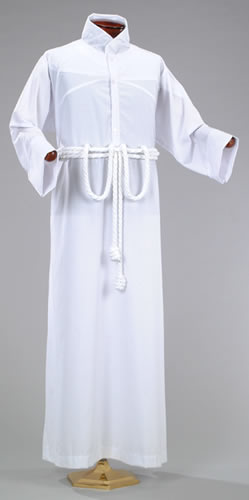
|
| THE VESTMENT OF ALL THE BAPTIZED |
| ALB WITH STOLE |
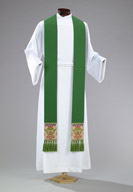
|
| A DOUBLE BREASTED CASSOCK |

|
| THE "WORKING GARMENT" WORN UNDER THE ALB OR WITH A WHITE SURPLICE |
| CASSOCK AND SURPLICE |
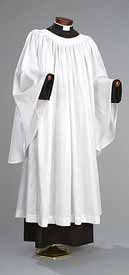
|
| CASSOCK AND SURPLICE WITH STOLE |
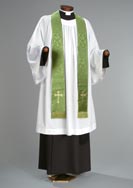
|
| MODEL SHOWING HOW A RABAT IS WORN |
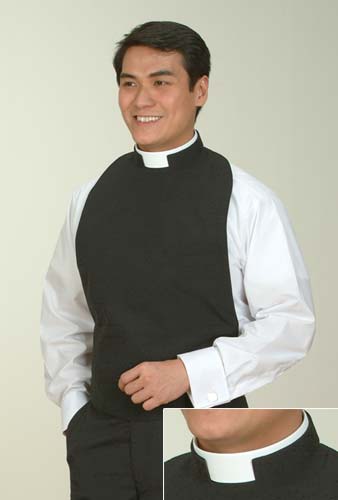
|
|

